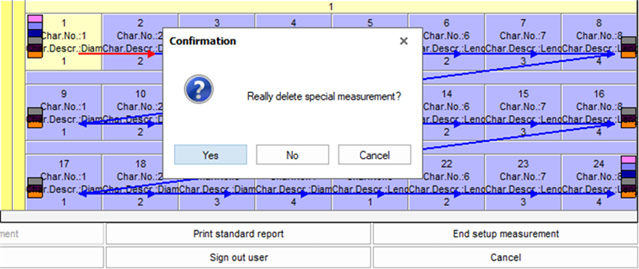A measurement procedure contains the defined measurements, subgroups, number of test objects to be measured as well as the characteristics to be measured and their frequencies. If a data set is loaded in procella, the measurement value recording follows the defined measurement procedure. With the special measurement, it is possible to do measurements with a different measurement procedure.
|
A special measurement can be used, for example, to record |
|
|
|
extended measurement procedures |
|
|
separated measurement procedures |
|
|
labelled characteristics |
|
|
Measurement procedures that are not included in the statistical evaluation (interim measurement) |
In addition to the handling and configuration of the special measurements, the configurations of the four mentioned scenarios are described roughly in this topic.
Table of Contents
Handling of the special measurements
Before configuring special measurements, it is important to make several considerations about the management and required behaviour of the special measurements.
Configuration deployment
The configurations of the special measurements are stored in the configuration database user and module specific. The configuration deployment follows the inheritance according to the configuration management. Thus, the settings can be stored user-group-specific or user-specific.
The standard delivery contains five configurations of the special measurement. These are created when the "Special measurements" dialogue is called up for the first time and saved in the configuration database when the application is closed.
Special measurement in the measurement procedure
Up to version 14.0.4.6, special measurements are handled independently of the configurations of a measurement process. All measurements, subgroups, number of test objects and characteristics defined in the test plan as well as the defined subgroup frequencies have no influence on the special measurement. When a special measurement is started, the test plan graphic shows the characteristics with the subgroup size "2" and the subgroup type “moving”.
Here on the left is a 'normal' measurement. On the right is a special measurement.
As of version 14.0.4.6, subgroup incidences can also be used for special measurements.
Starting a special measurement
A special measurement can be started either automatically or manually. To start a special measurement manually, it is necessary to include the required special measurement in the application bar of the "Summary/input" window. The configuration deployment of the application bars is described in a separate document.
Special Measurement - Configuration
The special measurements are managed and configured via the dialogue of the same name. It is called up via the "Settings" tab in the ribbon.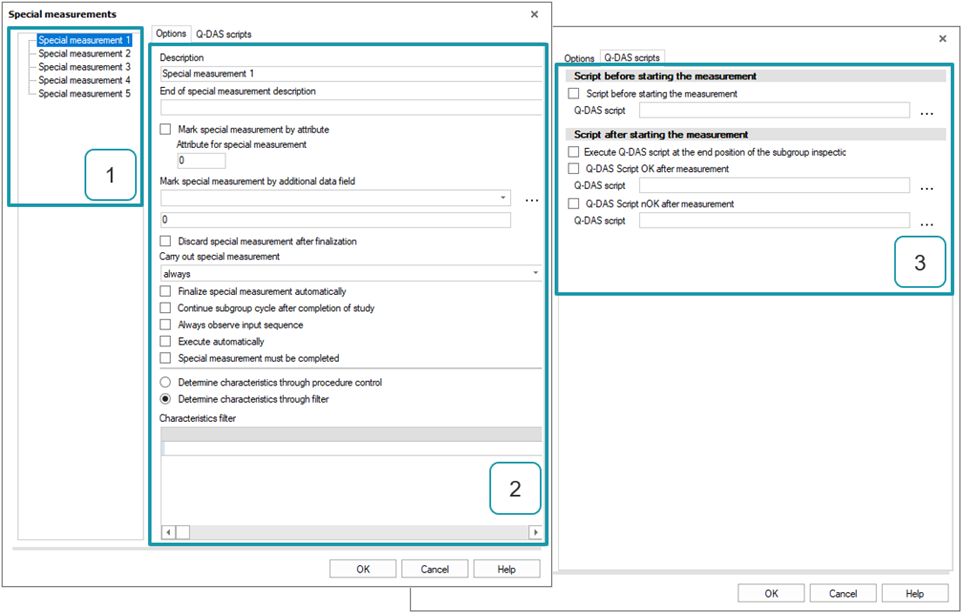
|
1 |
“Navigation” window area |
|
2 |
“Configuration” tab |
|
3 |
“Q-DAS scripts” tab |
The configuration and handling of the application bars are described in a separate document.
The example shows a section of the "Summary/input" window with the added "Special measurement 1" in the application bar.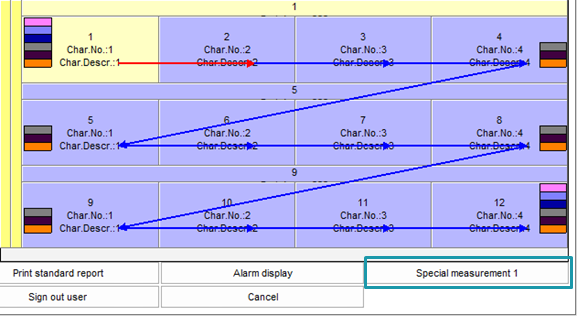
“Navigation” Window Area
This window area is not only used to list defined special measurements. By using the context menu and selecting the option "Add", it is possible to create new special measurements. By selecting the option "Delete", the previously selected configuration of a special measurement is removed.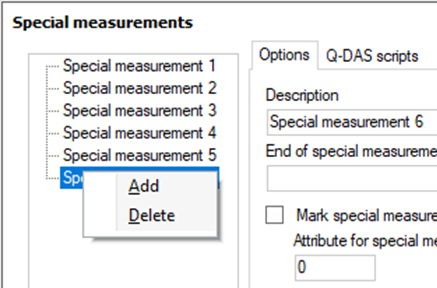
Five configurations of the special measurements are included in the standard delivery. The special measurements of the standard delivery have a protected status. The configuration of these can be individually adjusted but not deleted. 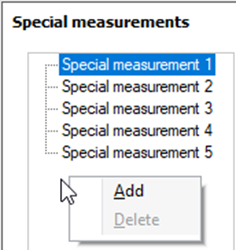
“Configuration” Tab
The actual definition of a special measurement is done in the configuration area. After selecting the special measurement to be configured in the navigation area, the configuration details are displayed in this window area.
Designation
The designation of the configuration of a special measurement is stored in the "Description" field. When creating new special measurements, a designation is specified by the application. This consists of the word "special measurement" in the current national language and a consecutive number. The designation is also used to label the buttons for starting or ending a special measurement. If there is no entry in the field "End of special measurement description", the button for ending a started special measurement is labelled "End".
Mark measured values
Each value that is recorded within a special measurement can be marked with an attribute or an additional data field.
The selection of the marking is done by a combination of the options.
Attributes
To activate the marking through attributes, the option "Mark special measurement by attribute " must be activated. The attribute used to identify the special measurement must be defined in the field "Attribute for special measurement". The attribute is only used if additional data fields are deactivated. This is the case if nothing or "None" is stored in the field "Mark special measurement by additional data field".
Measured values with the attributes "129", "190" and "255" are excluded from the statistical evaluation.
Additional data fields
To activate the marking by additional data field, select an additional data field in the field "Mark special measurement by additional data field". The content with which the special measurement is marked must be entered in the field below.
In the case of catalogue-based additional data fields, the input is made via a selection dialogue, which is called up via the "..." button. If no catalogues are included, the selection dialogue is empty.
Manual input is required for alphanumeric additional data fields.
Discard Measurement
Activating the option "Discard special measurement after finalization" allows to discard a special measurement after it has been recorded. Discarding a special measurement always requires confirmation by the operator.![]()
If this option is activated, the following prompt appears after a special measurement has been recorded. If the recorded special measurement is to be deleted, confirm this with the "Yes" button. If the buttons "No" or "Cancel" are selected, the special measurement remains.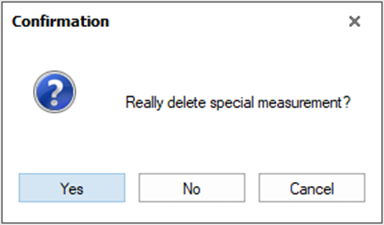
Time of Execution
If a special measurement is started manually, the options in this selection dialogue determine when the user may perform a special measurement. With the additionally activated option "Execute automatically", the options in this selection dialogue specify the start time of the automatic execution of a special measurement. The option "Execute automatically" is an extension option. It can only be used in combination with a selected time option.
When triggering a special measurement manually at a time that is not permitted, the following message appears.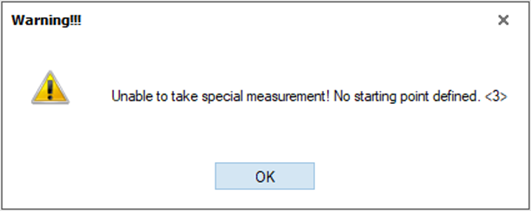
Further Settings
This window area defines the basic behaviour of a special measurement.
"Finalize special measurement automatically" option
If this option is activated, the system automatically switches to normal recording after a special measurement has been completely recorded. This means that only one measurement can be recorded for each special measurement started.
If the option is deactivated, several measurements can be recorded for a started special measurement. Switching to the normal measurement procedure is done manually by selecting the button to end the started special measurement.
"Continue in subgroup cycle after completion of study" option
By activating the option, the recording position of the normal data recording is saved when starting a special measurement. After the special measurement is finished, normal data recording continues at this saved position. If the option is not set, the input memory is deleted when a special measurement is started.
“Always observe input sequence” option
By activating this option, the input position is retained when a special measurement is started. Within the special measurement, a manual change of characteristic is therefore not allowed.
“Execute automatically” option
An extension option to the time of execution option. Detailed information can be found in the chapter Time of execution.
Options "Special measurement must be completed"
By activating this option, the operator is obliged to completely finish a started special measurement. If the special measurement is not completely recorded, it is not possible to finish it and thus switch to the normal measurement procedure.
"Record special measurement as a subgroup"
Up to version 14.0.4.6, special measurements are handled independently of the configurations of a measurement process. All measurements, subgroups, number of test objects and characteristics defined in the test plan as well as the defined subgroup frequencies have no influence on the special measurement. When a special measurement is started, the test plan graphic shows the characteristics with the subgroup size "2" and the subgroup type “moving”.
Here on the left is a 'normal' measurement. On the right is a special measurement.
As of version 14.0.4.6, the option "Record special measurement as a subgroup" is available. This allows the subgroup incidences to be used for special measurements.
Special measurement identifier
The characteristics used in a special measurement are identified with the options available here. 
Option "Determine characteristics through procedure control"
All characteristics with the subgroup incidence "-1" are hidden in the normal measurement procedure and can only be recorded in a special measurement run. This option enables the recording of all characteristics of a data set. This means the characteristics of the normal measurement procedure as well as the characteristics with the subgroup incidence "-1". If the option is activated, the subgroup incidence is not used in a special measurement.
Option "Determine characteristics through filter"
The filter criteria defined here are used to identify characteristics for the special measurement. Adding or removing the individual filters is done via the context menu. The filter criterion is done by manual input.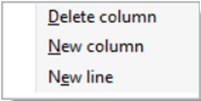
The classic example is the filter on the subgroup incidence "-1". Characteristics with the subgroup incidence "-1" can only be recorded via a special measurement. These are not included in the normal measurement procedure. ![]()
With several rows and columns, various filter combinations can be created. Criteria in different rows in one column are combined by OR, criteria of the different columns are combined by AND.
If no characteristics are identified for the loaded data pool when a special measurement is started, the following message is displayed.
“Q-DAS scripts” tab
The options in this window area enable the execution of a Q-DAS script for a special measurement.
Q-DAS scripts before a special measurement
To execute a Q-DAS script before recording a special measurement, activate the option "Script before starting the measurement" and store the script file under "Q-DAS script".
Q-DAS scripts after a special measurement
The execution of a Q-DAS script after the acquisition of a special measurement can be done in a general way or according to the measurement specifications.
As a general rule after the special measurement
If the option "Execute Q-DAS script at the end position of the subgroup inspection" is activated, the script file stored in the external files is executed after the end of a special measurement. The dialogue for configuring the external files can be called up via <File> | <Configurations> | <Further settings> | <External files>.
After the special measurement according to the measurement specifications
- "Q-DAS script OK after measurement" option
To execute a Q-DAS script after the complete recording of a successful special measurement (OK), activate the option and store a Q-DAS script file via the "..." button. - "Q-DAS Script nOK after measurement" option
To execute a Q-DAS script after the complete recording of an unsuccessful special measurement (nOK), activate the option and store a Q-DAS script file via the "..." button.
Special measurement - scenarios
Four application scenarios of the special measurement are described below.
Extended measurement procedure through special measurement
The task in this scenario is to measure a few characteristics in a normal measurement procedure. In a special measurement, all characteristics of a data set are to be measured.
A data set with eight characteristics is used. The four characteristics with the designation "Diameter" are always measured. In the case of a special measurement, the characteristics with the designation "Length" are also measured. The characteristics with the designation "Diameter" have the subgroup incidence "1". All characteristics with the designation "Length" have the subgroup incidence "-1". The characteristics with the subgroup incidence "-1" are hidden in the normal measurement procedure. These can only be recorded in a special measurement run.
For this task, the special measurement configuration is as follows: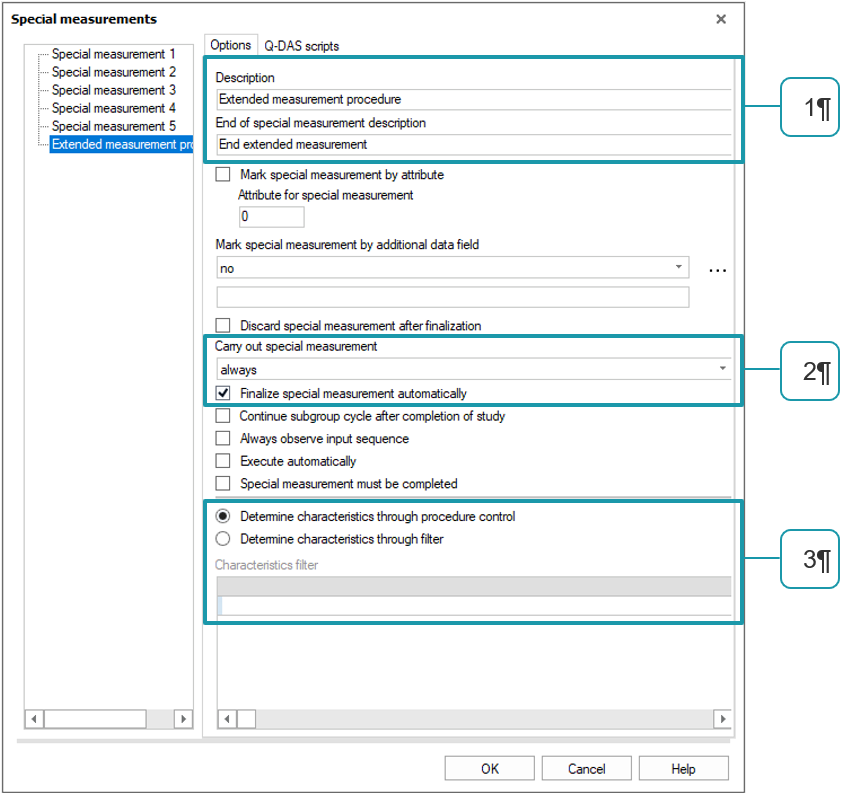
|
1 |
Designation of the special measurement as well as the labelling of the "Start" and "End" buttons in the application bar of the "Summary/input" window. |
|
2 |
With the "Finalize special measurement automatically" option activated, one measurement can be recorded for each special measurement started. If all characteristics of a special measurement are recorded, the system automatically switches to the normal measurement. |
|
3 |
With the activated option "Determine characteristics through procedure control", the characteristics with the subgroup incidence "-1" are also used when identifying the characteristics for the special measurement. |
After loading the data set, the test plan shows the characteristics of the normal measurement procedure. The button for starting the special measurement is integrated in the application bar. The designation of the special measurement is used for the button labelling. Selecting the button "Extended measurement procedure" starts the special measurement.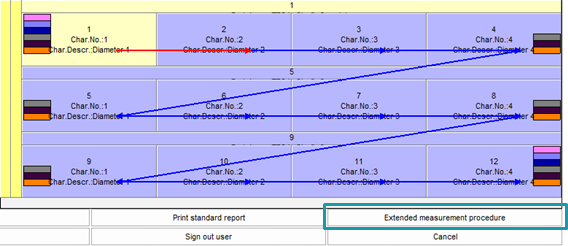
All measurements, subgroups, number of test objects and characteristics to be measured as well as the frequencies defined in the test plan have no influence on the special measurement.
When a special measurement is started, the configurations of the special measurement are used and the test plan is displayed accordingly. When a special measurement is started, the content of the field "End of special measurement description " is used to label the button.
According to the configuration, the special measurement includes all characteristics of the data set. Only one measurement can be carried out for the started special measurement. 
Separate measurement procedures
The task in this scenario is to measure certain characteristics in a normal measurement procedure. In a special measurement, all other characteristics, i.e., characteristics that are not included in a normal measurement procedure, are to be measured.
A data set with eight characteristics is used. The four characteristics with the designation "Diameter" are always measured. In a special measurement, only the characteristics with the designation "Length" are measured. The characteristics with the designation "Diameter" have the subgroup incidence "1". All characteristics with the designation "Length" have the subgroup incidence "-1". The characteristics with the subgroup incidence "-1" are hidden in the normal measurement procedure. These can only be recorded in a special measurement run.
For this task, the special measurement configuration is as follows:
|
1 |
Designation of the special measurement as well as the labelling of the "Start" and "End" buttons in the application bar of the "Summary/input" window. |
|
2 |
With the "Finalize special measurement automatically" option activated, one measurement can be recorded for each special measurement started. If all characteristics of a special measurement are recorded, the system automatically switches to the normal measurement. |
|
3 |
With the activated option "Determine characteristics through filter" and the setting of the characteristic filter "Subgroup incidence -1", the characteristics for the special measurement are identified. |
After loading the data set, the test plan shows the characteristics of the normal measurement procedure. The button for starting the special measurement is integrated in the application bar. The designation of the special measurement is used for the labelling of the button. Selecting the button "Characteristics exclusively for special measurement" starts the special measurement.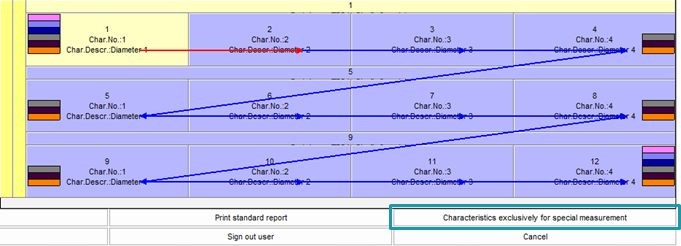
All measurements, subgroups, number of test objects and characteristics to be measured as well as the frequencies defined in the test plan have no influence on the special measurement.
When a special measurement is started, the configurations of the special measurement are used and the test plan is displayed accordingly. When a special measurement is started, the content of the field "End of special measurement description" is used to label the button.
According to the configuration, the special measurement only includes the characteristics with the subgroup incidence "-1". Only one measurement can be carried out for the started special measurement.
Special measurement for marked characteristics
The task in this scenario is to measure all characteristics of a data set in a normal measurement procedure. In a special case, it should be possible to additionally measure characteristics with defined identification via a special measurement that can be triggered manually.
A data set with eight characteristics is used. In the special case, the characteristics that are to be measured additionally are marked with defined information. In this example, the field "Characteristic Abbreviation" (K2003) and the content "x" are used. The characteristics of the special measurement are identified by the content "x" in the field "Characteristic short description".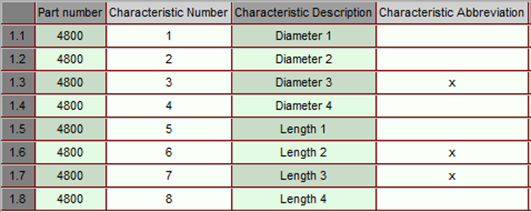
For this task, the special measurement configuration is as follows: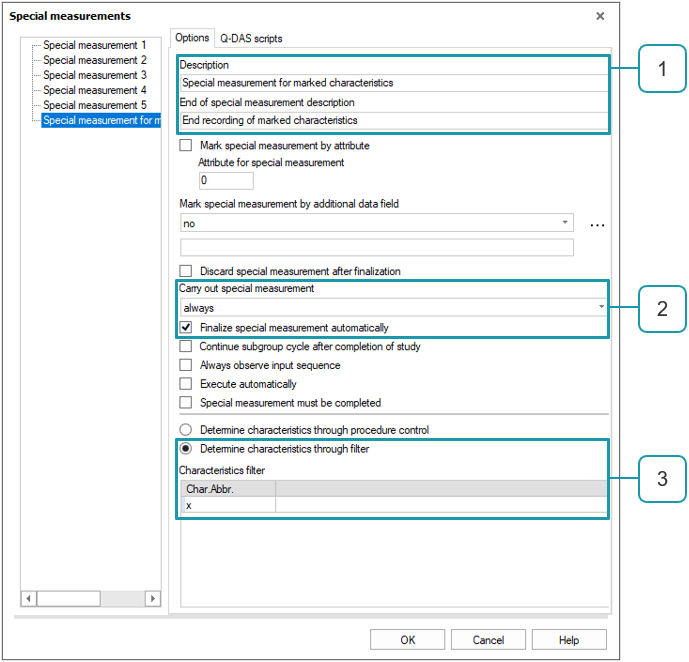
|
1 |
Designation of the special measurement as well as the labelling of the "Start" and "End" buttons in the application bar of the "Summary/input" window. |
|
2 |
With the "Finalize special measurement automatically" option activated, one measurement can be recorded for each special measurement started. If all characteristics of a special measurement are recorded, the system automatically switches to the normal measurement. |
|
3 |
With the activated option "Determine characteristics through filter" and the setting of the characteristic filter "Char.Abbr. x", the characteristics for the special measurement are identified. |
After loading the data set, the test plan shows the characteristics of the normal measurement procedure. The special measurement is integrated in the application bar. The designation of the special measurement is used for the labelling of the button. Selecting the button "Special measurement for marked characteristics" starts the special measurement.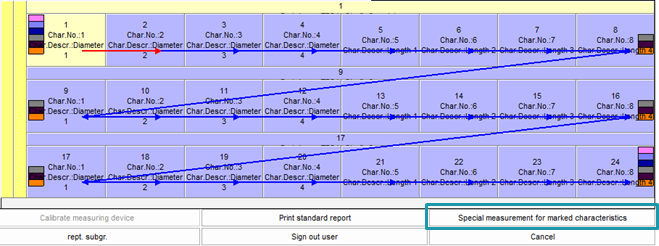
All measurements, subgroups, number of test objects and characteristics to be measured as well as the frequencies defined in the test plan have no influence on the special measurement.
When a special measurement is started, the configurations of the special measurement are used and the test plan is displayed accordingly. When a special measurement is started, the content of the field "End of special measurement description" is used to label the button.
According to the configuration, the special measurement only contains the characteristics with the characteristic abbreviation "x". Only one measurement can be carried out for the started special measurement.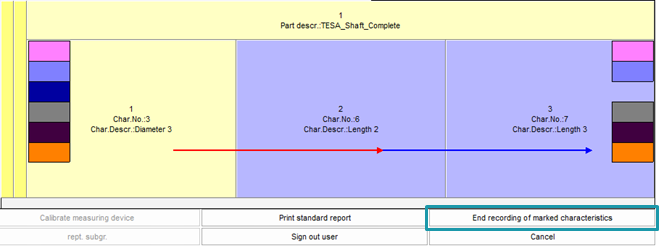
Interim measurement
This scenario is about not wanting a recorded measurement to be included in the statistical evaluation.
When setting up production machines, it may well happen that the user wants to measure a component but does not want the measured values to be saved in the database together with those of the SPC. There are two solutions for this type of interim measurement.
One possibility is to save the data set as a DFQ file and use it for the interim measurement. Another possibility is the special measurement.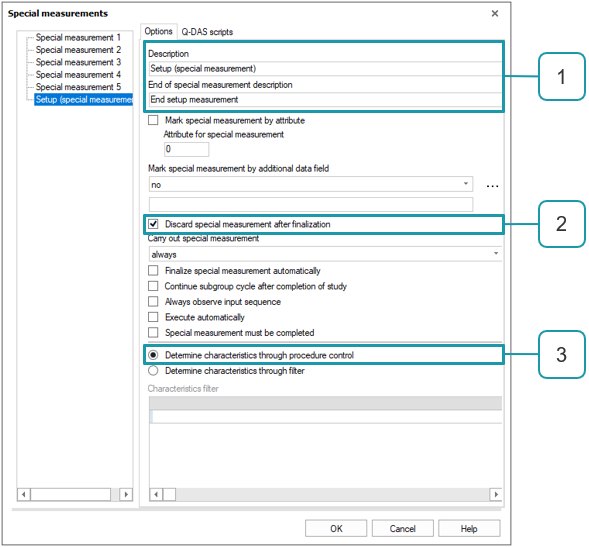
|
1 |
Designation of the special measurement as well as the labelling of the "Start" and "End" buttons in the application bar of the "Summary/input" window. |
|
2 |
The activated option "Discard special measurement after finalization" allows to discard the special measurement after it has been recorded. |
|
3 |
With the option "Determine characteristics through procedure control" activated, all characteristics of a data set are used for the special measurement identification. |
After loading the data set, the test plan shows the characteristics of the normal measurement procedure. The special measurement is integrated in the application bar. The designation of the special measurement is used for the button labelling. Selecting the button "Setup (special measurement)" starts the special measurement.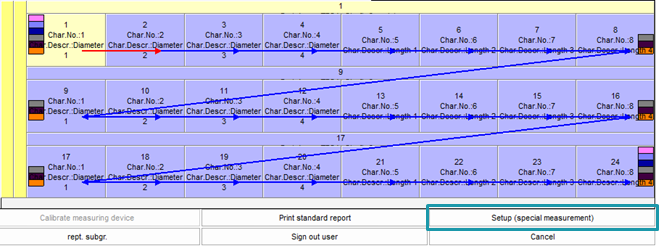
All measurements, subgroups, number of test objects and characteristics to be measured as well as the frequencies defined in the test plan have no influence on the special measurement. As of version 14.0.4.6 this is possible by enabling the "Record special measurement as a subgroup" option.
When a special measurement is started, the configurations of the special measurement are used and the test plan is displayed accordingly. When a special measurement is started, the content of the field "End of special measurement description" is used to label the button.
According to the configuration, the special measurement contains all characteristics of the data set. For the started special measurement, the test plan initially represents only one measurement.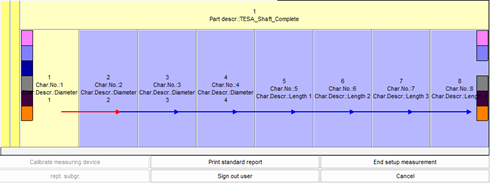
Any number of measurements can be recorded until the special measurements are stopped via the button in the application bar. In the picture on the right, three measurements have been recorded.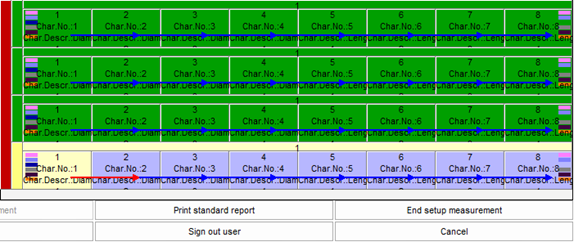
After selecting the button to end the special measurement, the system switches to the normal measurement procedure. According to the configuration, the prompt to discard the recorded special measurement is displayed.